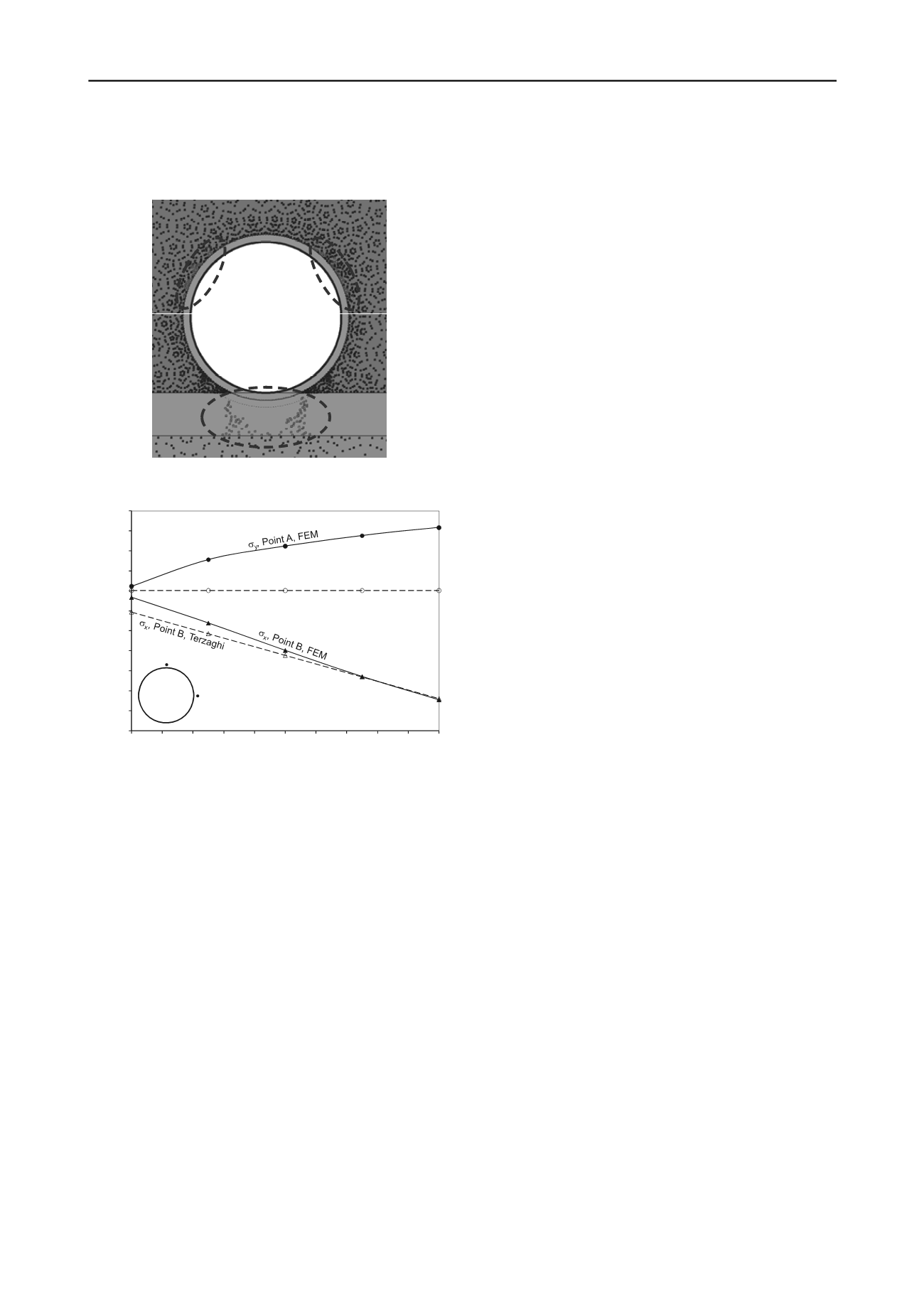
1768
Proceedings of the 18
th
International Conference on Soil Mechanics and Geotechnical Engineering, Paris 2013
explained by the fact that the FEM takes into account the
interaction liner-soil that develops both during the construction
and serviceability stages.
Figure 6. Stage 4, plastic stress point
70
90
110
130
150
170
190
210
230
250
270
290
0 10 20 30 40 50 60 70 80 90 100
Esfuerzo total, kPa
Abatimiento considerado, %
A
B
Tunnel
y
, Point A, Terzaghi
Total stress, kPa
Piezometric drawdown, %
Figure 7. Variation of total stresses with piezometric drawdown
4 CONCLUSIONS
A detailed description of the methodology employed for the
analysis and design of the definitive liner of a tunnel that will be
part of the Mexico City drainage system has been presented.
Part of this tunnel crosses through the clayey soils of the lake
zone in Mexico City valley.
It has been shown that unloading associated to the removal
of excavated soil produces a general upward movement of the
tunnel (“bubble” effect). As the excess of pore pressure
dissipates, a decrement of the effective stresses in the soil
located underneath the tunnel is produced. The stress decrement
originates that the clayey soil in such zone is transformed in a
pre-consolidated material, which becomes less compressible
that the surrounding zone. Because of this, as the definitive liner
is placed and the excess of pore pressure generated by the
piezometric drawdown dissipates, the soil below the tunnel
settles down at a lower rate than the surrounding soil. Therefore,
the tunnel experiences an apparent emersion with respect to the
surrounding media.
It was observed as well that during the piezometric
drawdown process, the secondary liner will be subjected to a
very unfavourable loading condition from a structural point of
view. Indeed, the upper part of the tunnel is submitted to a load
increment generated by the apparent emersion of the tunnel, and
at the same time, the sides of the tunnel experience a loss of
confinement due to a reduction of water pressure. The
unloading process developed on the sides of the tunnel can be
estimated using Terzaghi’s effective stress principle.
It has been confirmed that the FEM is a powerful tool for
analysing and designing tunnels in those difficult conditions,
since it allows: 1) considering different constitutive laws for the
materials involved; 2) simulating the phenomenon of
consolidation of the medium, due to excavation and
construction of the tunnel and piezometric drawdown and 3)
considering the interaction between liners and soil.
5 ACKNOWLEDGEMENT
These analyses were performed as part of the consulting
services provided by the authors to CONAGUA (water
authority in Mexico) for the design of “Túnel Emisor Oriente”
being built in Mexico Valley.
6 REFERENCES
Alberro, J. (1983). "Presiones de roca en túneles e interacción roca-
revestimiento". Instituto de Ingeniería, UNAM.
Alberro, J. & Hernández, R. (1989). "Efecto del flujo de agua en el
contorno de túneles". Instituto de Ingeniería, UNAM, No. 517.
Auvinet, G. & Rodríguez-Rebolledo, J.F. (2010). "Analysis, design,
construction and behavior of underground structures". XXV
RNMSeIG, Vol. 1, Acapulco: 33-42.
Bobet, A. (2001). "Analytical solutions for shallow tunnels in saturated
ground". Journal of Engineering Mechanics, ASCE Vol. 127 (12):
1258–1266.
Curtis, D.J. (1976). "Discussion on the Circular Tunnel in Elastic
Ground". Géotechnique, Vol. 26, No. 1: 231-237.
Equihua, L.N. (2000). “Túneles en suelos blandos con hundimiento
regional”. MEng thesis, UNAM.
Farjeat, E. & Delgado, S. (1988). “Diseño de dovelas para túneles del
metro alojadas en arcillas compresibles de la Ciudad de México”.
Tunnels and Water, Serrando (ed), Balkema, Rotterdam: 117-135.
Flores, F.A. (2010). “Análisis del comportamiento estático de túneles
excavados en suelos blandos”. Tesis para obtener el grado de
Maestro en Ingeniería. Programa de Maestría y Doctorado en
Ingeniería, UNAM.
Kirsch (1898). "Die Theorie der Elastizität und die Bedürfnisse der
Festigkeitslehre". Zeitschrift des Vereines deutscher Ingenieure,
Vol. 42: 797–807.
Morgan, H. (1961). "A contribution to the analysis of stress in a circular
tunnel". Géotechnique, Vol. 11: 37-46.
Wood, M. (1975). The circular tunnel in elastic ground. Géotechnique,
No. 1, pp 115-127.
Zaldívar, S.F., Rodríguez-Rebolledo, J.F. & Auvinet, G. (2012). “Stress
and displacements distribution around a tunnel taking into account
the "bubble effect"”, 2º Simposio Internacional sobre túneles y
lumbreras en suelos y roca, Mexico City.


